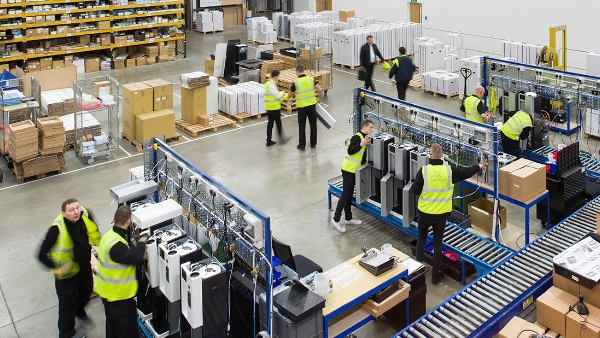How we transformed production using Lean Thinking

Over the last 12 to 18 months we’ve made changes to our production line to increase efficiency and accommodate future growth. It’s part of a wider ongoing commitment across the business to continually improve our products and services.
Neil Fulcher, Production Manager, is the brains behind the improvements we’ve made to production. He has extensive experience implementing change in manufacturing and is a graduate of Porsche Consulting’s Lean training.
Thanks to his dedication, and that of the wider team, we have made significant efficiency savings, raised the bar on quality, and further improved working standards for the team.
What is Lean? – Lean is a business methodology focused on delivering value for the customer by improving the flow of products and services.
Redesigning the production line
Lean manufacturing wasn’t a new concept to Borg & Overström. But thanks to Neil’s enthusiasm and experience, we’ve been able to bring the whole team on the journey and make lasting changes.
“Lean is about running small workshops to get the team thinking about making efficiencies and to encourage Lean Thinking,” Neil explains. Getting the team on board was key to success, so Neil began by running a workshop. The purpose of which was to demonstrate to the team what Lean is and how it can be used to improve production flow.
Neil led the team through a Lean simulation using cardboard boxes. By following a process of continual improvement, the team was able to turn an imaginary failing production line into one that delivered products at regular, predictable intervals.
Neil also ran a desktop simulation of the actual Borg & Overström production line. This led to a redesign of the line, and a prototype to prove it worked, before we invested in the line we have today.

An improved production flow
Flow through an entire system is key to Lean production. One of the most significant changes made to the line was to parts picking. Neil applied Kanban, a popular Lean logistics method used by the likes of Porsche and Toyota to ensure quality and efficiency of movement. All commonly used parts are now contained in bins that are regularly topped up. “This means the line never stops due to lack of parts,” says Neil.
He also employed a technique called Poka Yoke, or fail safes that help prevent human error. When an order comes through needing specific parts, these are put in a cage and sent to the line as a kit. Any parts left in the cage alerts the team to a potential quality concern.
“We have made significant efficiencies, which have improved quality and working conditions for our staff. But it’s a continuous journey,” Neil adds. “The next step is to apply Lean principles to product development to improve how new products are delivered to time and quality standards.”
A Lean philosophy
We are continuing to build a Lean philosophy throughout Borg & Overström. In addition to redesigning the production line, we have also made improvements in our warehouse to ensure the production line is fed efficiently and on time.
We have also introduced an employee Opportunity For Improvement (OFI) scheme. Any team member is welcome to pitch an idea according to predetermined criteria. If an idea results in a saving, we will give 10% of the first 12-month saving to the team member who made the suggestion.
As a result of the changes to production and the warehouse, the system can cope with another 20 to 30 per cent growth. This is without increasing floor space or the team working more shifts. From producing 30,000 units when we started the programme, we can comfortably accommodate the 52,000 we expect to produce this year.

